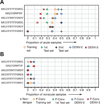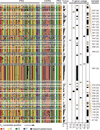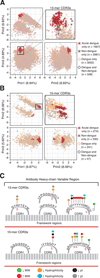Convergent antibody signatures in human dengue
- PMID: 23768493
- PMCID: PMC4136508
- DOI: 10.1016/j.chom.2013.05.008
Convergent antibody signatures in human dengue
Abstract
Dengue is the most prevalent mosquito-borne viral disease in humans, and the lack of early prognostics, vaccines, and therapeutics contributes to immense disease burden. To identify patterns that could be used for sequence-based monitoring of the antibody response to dengue, we examined antibody heavy-chain gene rearrangements in longitudinal peripheral blood samples from 60 dengue patients. Comparing signatures between acute dengue, postrecovery, and healthy samples, we found increased expansion of B cell clones in acute dengue patients, with higher overall clonality in secondary infection. Additionally, we observed consistent antibody sequence features in acute dengue in the highly variable major antigen-binding determinant, complementarity-determining region 3 (CDR3), with specific CDR3 sequences highly enriched in acute samples compared to postrecovery, healthy, or non-dengue samples. Dengue thus provides a striking example of a human viral infection where convergent immune signatures can be identified in multiple individuals. Such signatures could facilitate surveillance of immunological memory in communities.
Copyright © 2013 Elsevier Inc. All rights reserved.
Figures





Similar articles
-
Mapping the Human Memory B Cell and Serum Neutralizing Antibody Responses to Dengue Virus Serotype 4 Infection and Vaccination.J Virol. 2017 Feb 14;91(5):e02041-16. doi: 10.1128/JVI.02041-16. Print 2017 Mar 1. J Virol. 2017. PMID: 28031369 Free PMC article.
-
Approaches to Interrogating the Human Memory B-Cell and Memory-Derived Antibody Repertoire Following Dengue Virus Infection.Front Immunol. 2019 Jun 6;10:1276. doi: 10.3389/fimmu.2019.01276. eCollection 2019. Front Immunol. 2019. PMID: 31244836 Free PMC article. Review.
-
Lower IgG somatic hypermutation rates during acute dengue virus infection is compatible with a germinal center-independent B cell response.Genome Med. 2016 Feb 25;8(1):23. doi: 10.1186/s13073-016-0276-1. Genome Med. 2016. PMID: 26917418 Free PMC article.
-
Persistence of circulating memory B cell clones with potential for dengue virus disease enhancement for decades following infection.J Virol. 2012 Mar;86(5):2665-75. doi: 10.1128/JVI.06335-11. Epub 2011 Dec 14. J Virol. 2012. PMID: 22171265 Free PMC article.
-
Modulation of Dengue/Zika Virus Pathogenicity by Antibody-Dependent Enhancement and Strategies to Protect Against Enhancement in Zika Virus Infection.Front Immunol. 2018 Apr 23;9:597. doi: 10.3389/fimmu.2018.00597. eCollection 2018. Front Immunol. 2018. PMID: 29740424 Free PMC article. Review.
Cited by
-
Dynamics of immunoglobulin sequence diversity in HIV-1 infected individuals.Philos Trans R Soc Lond B Biol Sci. 2015 Sep 5;370(1676):20140241. doi: 10.1098/rstb.2014.0241. Philos Trans R Soc Lond B Biol Sci. 2015. PMID: 26194755 Free PMC article.
-
Sequencing the functional antibody repertoire--diagnostic and therapeutic discovery.Nat Rev Rheumatol. 2015 Mar;11(3):171-82. doi: 10.1038/nrrheum.2014.220. Epub 2014 Dec 23. Nat Rev Rheumatol. 2015. PMID: 25536486 Free PMC article. Review.
-
nf-core/airrflow: An adaptive immune receptor repertoire analysis workflow employing the Immcantation framework.PLoS Comput Biol. 2024 Jul 26;20(7):e1012265. doi: 10.1371/journal.pcbi.1012265. eCollection 2024 Jul. PLoS Comput Biol. 2024. PMID: 39058741 Free PMC article.
-
Structural basis of a shared antibody response to SARS-CoV-2.Science. 2020 Aug 28;369(6507):1119-1123. doi: 10.1126/science.abd2321. Epub 2020 Jul 13. Science. 2020. PMID: 32661058 Free PMC article.
-
Protective natural autoantibodies to apoptotic cells: evidence of convergent selection of recurrent innate-like clones.Ann N Y Acad Sci. 2015 Dec;1362(1):164-75. doi: 10.1111/nyas.12788. Epub 2015 May 18. Ann N Y Acad Sci. 2015. PMID: 25990717 Free PMC article. Review.
References
-
- Altschul S, Gish W, Miller W, Myers E, Lipman D. Basic local alignment search tool. J. Mol. Biol. 1990;215:403–410. - PubMed
Publication types
MeSH terms
Substances
Grants and funding
LinkOut - more resources
Full Text Sources
Other Literature Sources
Medical

